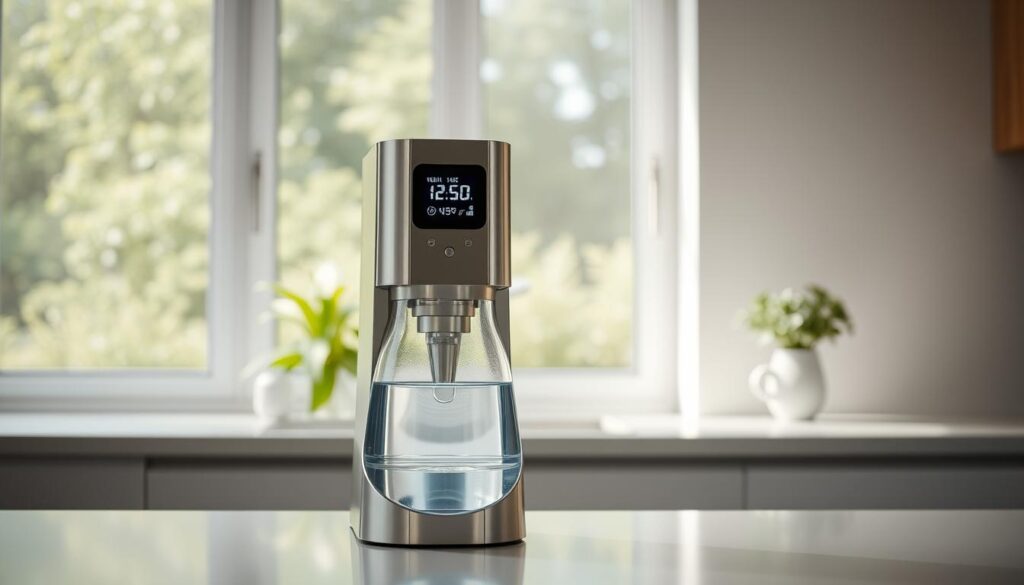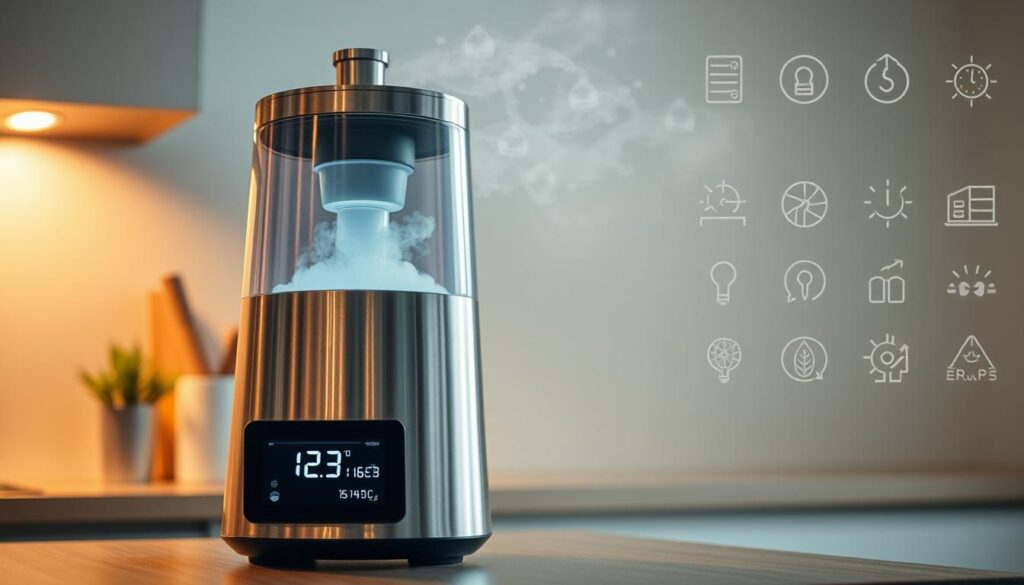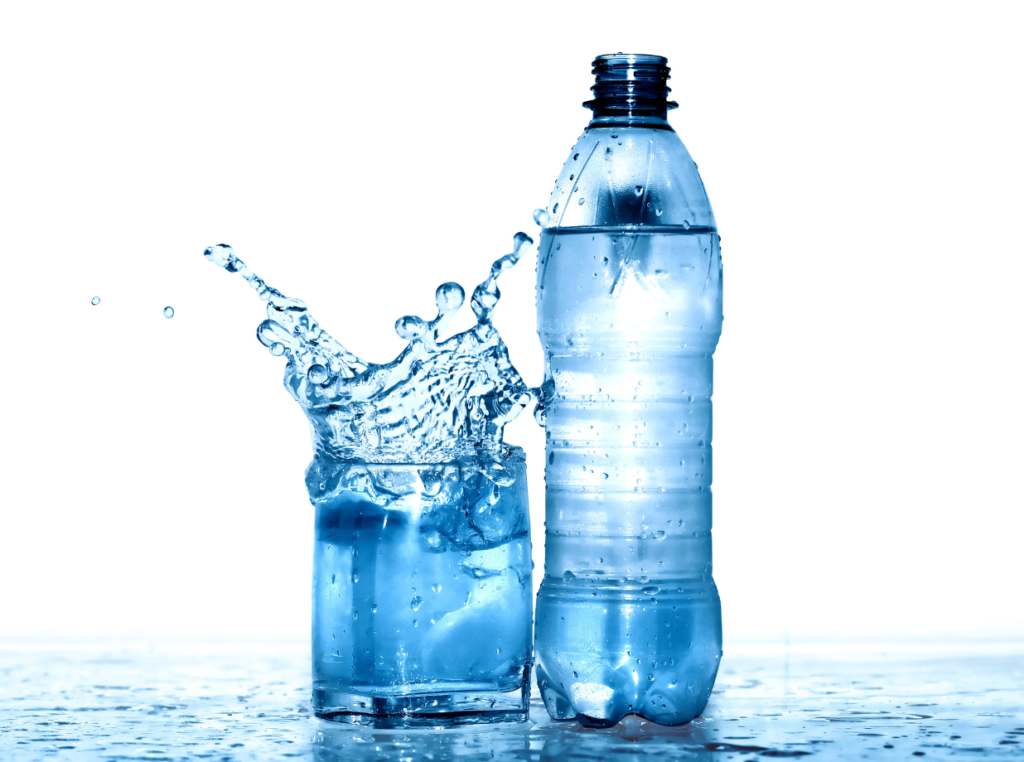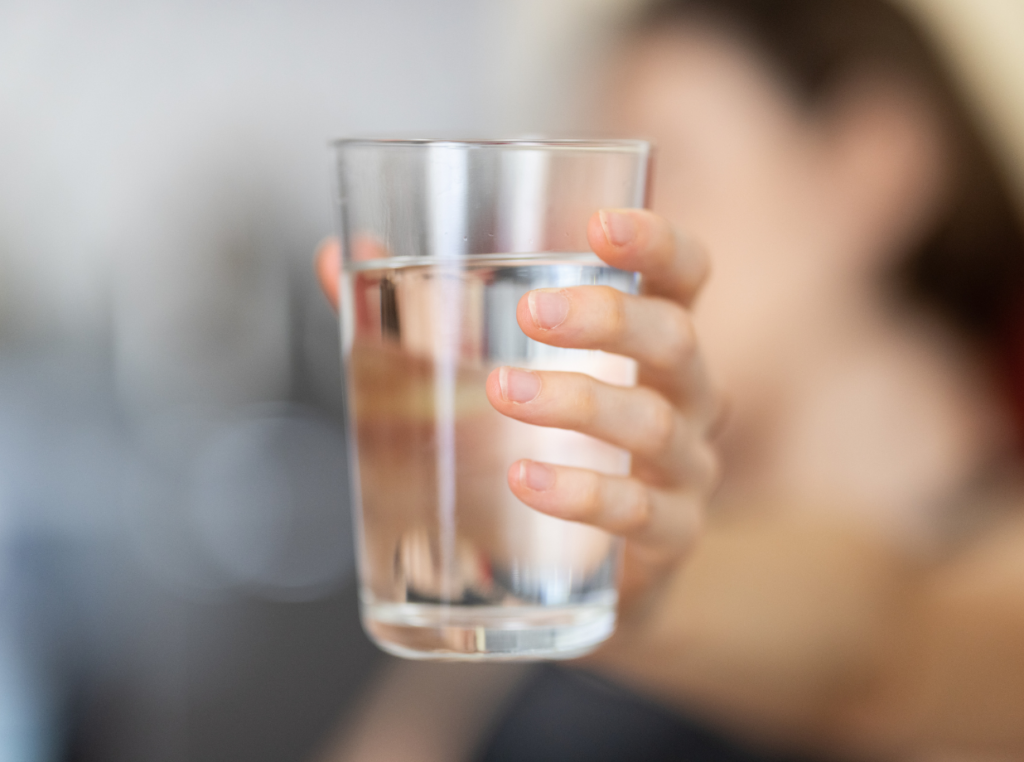Are you aware of the significant amount of energy consumed by household water distillers? According to Guangzhou Chunke Environmental Technology Co. Ltd., these devices do use a substantial amount of electricity.
This raises an important question: How can you make your water distiller more energy-efficient? As we explore this topic, we’ll discuss energy-saving tips and eco-friendly practices that can help reduce your energy consumption.
By implementing these simple and effective methods, you can enjoy the benefits of using a water distiller while minimizing its environmental impact.
Key Takeaways
- Simple methods to reduce energy consumption while using a water distiller
- Eco-friendly practices for water distilling
- Tips to make your water distiller more energy-efficient
- Benefits of energy-saving in household water distillers
- Environmentally friendly alternatives for water distillation
Understanding Water Distiller Energy Consumption
Understanding how water distillers work and their energy requirements can help users make informed decisions about their usage. Water distillers are appliances that purify water through the process of distillation, which involves boiling the water and then condensing the steam back into liquid form.
The Basics of How Water Distillers Operate
The distillation process begins with heating the water to its boiling point, turning it into steam. This steam is then cooled and condensed back into water, leaving many contaminants behind. The energy consumed by a water distiller is primarily used for heating the water.
Typical Energy Requirements and Costs
The energy requirements of a water distiller depend on its capacity and usage frequency. Typically, a water distiller consumes between 500 to 1000 watts of electricity per hour of operation. The cost of this energy can vary depending on local electricity rates, but users can expect to pay a few cents per hour of use.
Key Factors That Increase Energy Usage
Several factors can increase the energy consumption of a water distiller, including larger capacity models, frequent use, and poor maintenance. Ensuring proper maintenance, such as regular cleaning and descaling, can help reduce electricity usage and keep the distiller running efficiently.
By understanding these factors and choosing a cost-effective water distiller, users can enjoy purified water while minimizing their energy footprint.
Selecting Energy-Efficient Water Distiller Models
The key to saving energy with your water distiller lies in selecting a model with a high energy efficiency rating. As consumers become more environmentally conscious, manufacturers are responding with eco-friendly water distilling technologies.
Decoding Energy Efficiency Ratings and Labels
Energy efficiency ratings can be confusing, but understanding them is crucial. Look for models with clear labels indicating their energy consumption. These labels can help you compare different models and choose the most sustainable water distillation option.
Energy-Saving Features Worth the Investment
Some water distillers come with advanced features designed to reduce energy consumption. These include smart controls, automatic shut-off, and improved insulation. Investing in a model with these features can lead to significant long-term savings, aligning with green distillation practices.
Balancing Upfront Costs with Long-Term Energy Savings
While energy-efficient models might be more expensive initially, they can offer substantial savings over time. It’s essential to calculate the payback period to understand the cost-benefit analysis.
Payback Period Calculations
To calculate the payback period, divide the additional upfront cost of the energy-efficient model by the annual energy savings. This will give you the number of years it takes for the model to pay for itself through energy savings.
By choosing an energy-efficient water distiller and understanding its features and benefits, you can significantly reduce your energy consumption and contribute to a more sustainable future.
Optimal Operating Practices for Energy Conservation
Operating a water distiller efficiently is key to reducing energy consumption and promoting environmentally conscious distilling. By implementing a few simple strategies, you can significantly lower your energy usage.
Finding the Perfect Batch Size for Your Needs
One of the most effective energy-saving tips is to find the optimal batch size for your distiller. Running the distiller at full capacity can help reduce energy consumption per unit of water distilled.
Water Temperature Optimization Techniques
Pre-heating the water before distillation can also contribute to lower energy consumption. By starting with warmer water, you reduce the energy required to reach the boiling point.
Smart Timing to Minimize Energy Waste
Using timers and automation can help minimize energy waste by ensuring the distiller operates during off-peak hours or when it’s most needed.
Using Timers and Automation
Implementing timers and automation allows for more control over the distillation process, enabling you to save energy by running the distiller during periods of low energy demand. As
“Energy efficiency is about using less energy to perform the same task.”
Essential Maintenance for Improved Energy Efficiency
Proper upkeep of your water distiller can significantly improve its energy efficiency. Regular maintenance tasks are designed to keep your distiller running smoothly and effectively.
Creating an Effective Cleaning Schedule
To maintain your water distiller’s efficiency, it’s crucial to establish a regular cleaning schedule. This involves checking and cleaning the distiller’s components regularly to prevent the buildup of contaminants that can reduce its performance.
Proper Descaling to Maintain Heating Efficiency
Descaling is a critical maintenance task that removes mineral deposits that can impede the heating element’s efficiency. Regular descaling ensures that your distiller continues to operate at its optimal level, thereby reducing electricity usage.
When and How to Replace Critical Components
Over time, certain components of your water distiller may wear out or become less efficient. Knowing when to replace these parts is key to maintaining your distiller’s performance. Look out for signs such as decreased output or increased energy consumption.
Signs Your Distiller Is Using Excess Energy
If your distiller is using more energy than usual, it may be a sign that maintenance is needed. Common indicators include longer distillation times or the distiller not reaching the desired temperature. Regular checks can help identify these issues early on.

By following these maintenance tips, you can ensure your water distiller operates in a cost-effective and sustainable manner, contributing to sustainable water distillation practices.
Strategic Timing and Scheduling for Lower Energy Costs
By planning your water distillation process more efficiently, you can achieve substantial energy savings. One of the key strategies involves understanding and leveraging the timing of your distillation process to minimize energy expenses.
Taking Advantage of Off-Peak Electricity Rates
One effective way to lower energy costs is by utilizing off-peak electricity rates. Many utility companies offer discounted rates during certain hours of the day or night when demand is lower. By scheduling your water distillation during these off-peak hours, you can significantly reduce your energy bills.
Comparing Batch vs. Continuous Distillation Energy Usage
The choice between batch and continuous distillation also impacts energy consumption. Batch distillation involves distilling water in batches, which can be more energy-efficient for smaller quantities. Continuous distillation, on the other hand, is more suited for larger, consistent demands. Understanding your needs and choosing the right method can help optimize energy usage.
Adjusting Your Routine for Seasonal Efficiency
Adjusting your distillation routine according to seasonal changes can also contribute to energy efficiency. For instance, during colder months, the initial water temperature may be lower, requiring more energy to heat. Being aware of these changes allows you to plan accordingly and maintain optimal energy usage.
Implementing these strategies not only helps in reducing energy costs but also contributes to more eco-friendly water distilling practices.
Insulation Techniques to Reduce Heat Loss
One of the simplest ways to save energy while using a water distiller is by implementing proper insulation techniques. Proper insulation can significantly reduce heat loss during the distillation process, leading to lower energy consumption and more environmentally conscious distilling.
Budget-Friendly DIY Insulation Projects
For those on a budget, DIY insulation projects can be an effective way to reduce heat loss. Simple projects include wrapping the distiller with thermal insulation materials or using foam pipe insulation around the distillation apparatus. These methods are not only cost-effective but also easy to implement.
Professional-Grade Insulation Solutions
For a more durable and efficient solution, consider investing in professional-grade insulation. This can include high-quality thermal wraps or advanced materials like reflective insulation. While these options may have a higher upfront cost, they provide long-term energy savings and can be more effective in reducing heat loss.
Testing and Measuring Insulation Effectiveness
To ensure that your insulation efforts are paying off, it’s crucial to test and measure their effectiveness. This can be done by monitoring the distiller’s energy consumption before and after insulation installation. By doing so, you can identify areas for improvement and make adjustments as needed to maximize your energy-saving tips.
By implementing these insulation techniques, you can significantly enhance the efficiency of your water distiller, contributing to a more sustainable distillation process.
Water Source Considerations for Energy Efficiency
To achieve sustainable water distillation, it’s essential to consider the energy implications of the water source. The characteristics of the water, including its temperature and quality, can significantly affect the energy consumption of a water distiller.
How Starting Water Temperature Affects Energy Consumption
The temperature of the starting water is a crucial factor in determining the energy required for distillation. Cold water requires more energy to heat up to the boiling point, whereas warmer water reduces the energy needed for the distillation process.
| Starting Water Temperature | Energy Consumption |
|---|---|
| 40°F (4°C) | High |
| 60°F (15°C) | Moderate |
| 80°F (27°C) | Low |
Energy Benefits of Pre-Filtering Your Water
Pre-filtering the water before distillation can significantly reduce energy consumption. By removing impurities, pre-filtration improves the efficiency of the distillation process and prolongs the lifespan of the distiller.
Addressing Hard Water to Prevent Energy Waste
Hard water contains minerals that can lead to scaling in the distiller, reducing its efficiency and increasing energy consumption. Using a water softener or descaling solution can mitigate this issue, ensuring that the distiller operates at optimal levels.
By considering the water source and implementing strategies like pre-filtration and addressing hard water, users can significantly reduce their energy usage and achieve a more cost-effective water distiller operation.
Ways to Save Energy While Using a Water Distiller
Energy conservation is key to eco-friendly water distilling, and there are several strategies to achieve this. By implementing a combination of efficient practices and smart technologies, users can significantly reduce their energy consumption.
Combining Multiple Techniques for Maximum Savings
To achieve maximum energy savings, it’s essential to combine multiple techniques. This can include using energy-efficient water distiller models, optimizing operating practices, and implementing regular maintenance schedules. By adopting a holistic approach, users can minimize their energy footprint.

Quick Wins vs. Long-Term Energy Reduction Strategies
Some energy-saving strategies offer quick results, while others require a longer-term commitment. For instance, adjusting your distillation schedule to take advantage of off-peak electricity rates can yield immediate savings. In contrast, investing in a new, energy-efficient distiller model may require a larger upfront cost but can lead to significant long-term savings.
Creating a Sustainable Distillation Routine
Establishing a sustainable distillation routine is crucial for ongoing energy efficiency. This involves monitoring your energy consumption, adjusting your usage patterns, and maintaining your equipment regularly.
Sample Energy-Saving Schedules
| Distillation Frequency | Energy Consumption (kWh) | Cost Savings |
|---|---|---|
| Daily | 3.5 | $0.50/day |
| Every Other Day | 2.8 | $0.40/day |
| Weekly | 2.2 | $0.30/day |
By adopting these strategies and creating a tailored distillation schedule, users can enjoy significant energy savings while maintaining their water distiller’s performance.
Harnessing Alternative Energy for Water Distillation
The quest for greener distillation methods leads us to alternative energy sources for water distillers. As concern for the environment grows, so does the interest in making water distillation more sustainable.
Exploring Solar-Powered Distillation Options
Solar-powered distillation is an attractive option for those looking to reduce their carbon footprint. By harnessing the sun’s energy, distillers can significantly cut down on electricity costs and reliance on non-renewable energy sources.
Implementing Heat Recovery Systems
Heat recovery systems offer another avenue for increasing the energy efficiency of water distillers. These systems capture and reuse heat that would otherwise be wasted, thereby reducing the overall energy required for distillation.
Connecting Your Distiller to Renewable Energy Sources
For those with the capability, connecting your distiller to renewable energy sources such as wind or solar power can be a game-changer. This not only supports sustainable water distillation but also contributes to a reduction in greenhouse gas emissions.
| Alternative Energy Source | Potential Savings | Initial Investment |
|---|---|---|
| Solar Power | Up to 50% on energy costs | High |
| Heat Recovery Systems | 20-30% on energy costs | Moderate |
| Wind Power | Up to 70% on energy costs | Very High |
By embracing these alternative energy sources, individuals and organizations can make significant strides towards more sustainable water distillation practices. Whether through solar power, heat recovery, or renewable energy connections, the path to greener distillation is multifaceted and ripe with opportunity.
Tracking and Reducing Your Distiller’s Energy Footprint
The journey to a more energy-efficient water distiller begins with monitoring its energy consumption. By understanding how much energy your distiller uses, you can identify areas for improvement and implement changes to reduce your energy footprint.
Tools for Monitoring Electricity Consumption
To track your distiller’s energy usage, consider using a smart plug or an energy monitor. These devices provide real-time data on your distiller’s electricity consumption, helping you understand your energy usage patterns. Some models even offer historical data, allowing you to see how your energy consumption changes over time.
Calculating Your Real Energy Savings
To calculate your energy savings, compare your current energy consumption with your usage before implementing energy-efficient practices. You can use the data from your energy monitor to determine the exact amount of energy saved. This information will help you understand the effectiveness of your efforts and identify further opportunities for improvement.
Setting Progressive Efficiency Goals
Setting clear, achievable goals is crucial for continuously improving your distiller’s energy efficiency. Start by setting a specific target, such as reducing your energy consumption by a certain percentage within a set timeframe. Regularly review your progress and adjust your goals as needed.
Creating an Energy Usage Log
Maintaining an energy usage log can help you track your progress and identify patterns in your energy consumption. Record your distiller’s energy usage at regular intervals, noting any changes you’ve made to your operation. This log will serve as a valuable reference when assessing the effectiveness of your energy-saving measures.
Conclusion
By implementing the strategies discussed throughout this article, users can significantly reduce their energy consumption while using a water distiller. From selecting energy-efficient models to optimizing operating practices, there are numerous ways to save energy while using a water distiller.
Adopting eco-friendly water distilling practices not only reduces energy costs but also contributes to a more sustainable water distillation process. By combining techniques such as insulation, pre-filtering, and heat recovery, users can achieve substantial energy savings.
Embracing sustainable water distillation practices is a step towards a more environmentally friendly routine. As we’ve explored, there are various methods to make water distillation more energy-efficient. By applying these methods, individuals can enjoy the benefits of purified water while minimizing their environmental footprint.



